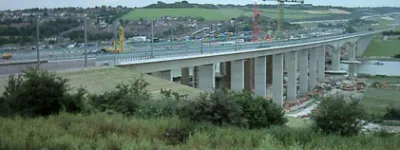The rapid development of the road network in the UK during the 1950s, 60s and 70s is well documented. Not only did the approach to roadbuilding change; the science of highway and traffic engineering became much more sophisticated too.
The development of modern road signs in the early 1960s is well documented; what's not so well known is that the same period saw innovation and experimentation with the relatively new idea of changeable signs.

Introduction
From the earliest attempts at variable message signs through to the present day, there have always been two basic technologies in use: mechanical and light displays.
Mechanical signs have two or more messages that can be displayed by sliding, scrolling or spinning sections of sign face into place with electric motors. Light displays can light up a message — either a fixed message, with lights behind it to make it visible, or by a whole matrix of smaller lights that can be lit in various patterns to produce text and symbols.
We take these technologies for granted today, but back in 1960 the concept of a road sign that could show one thing or another depending on the circumstances was almost unknown, at least in this country.
Over the following fifteen years, engineers in the UK developed both mechanical and electronic technologies to a point where, far from these signs being a novelty, British roads were equipped with some of the most advanced and complex roadside equipment anywhere in the world.
This article looks at some of the ingenious — and often bizarre — ideas that were tried out on the hapless British motorist.
Comments
I was hoping that Google might reveal what else the sign might say by looking back at previous dates, but alas all dates showed the same on the sign. Anyone know what other messages are hiding there?
It is twin panelled - right side has a red "A1(M) CLOSED AHEAD" sign, with a A168/diversion panel to the left
Add new comment
Sources
- Development of "secret" traffic signs and technologies; research into systems in use in Italy, USA and elsewhere: MT 126/53.
- Sign trials on M5 in Worcestershire: MT 95/668, MT 96/670.
- "Motorwarn" trials and installation: MT 95/924.
- Development of NCMS, M1 trials and MS1 signals: Ron Bridle, Peter Baldwin, John Porter, Robert Baldwin (ed.). 2002. "The Motorway Achievement: Frontiers of Knowledge and Practice". ICE Publishing.
With thanks to John O'Connell for information on this page.

I found the largest prism sign:
https://www.google.co.uk/maps/@54.1340368,-1.4219787,3a,75y,315.68h,90t…